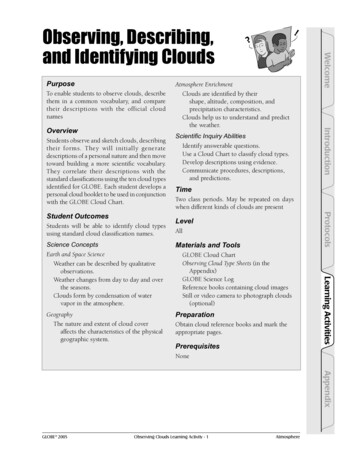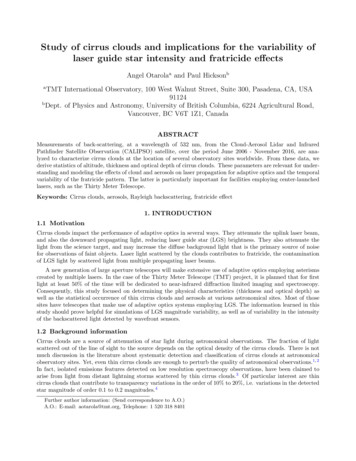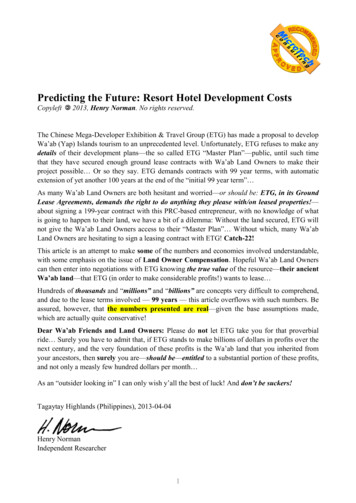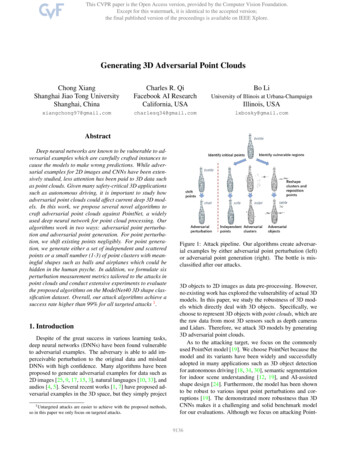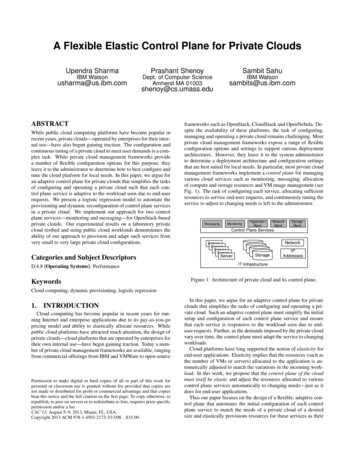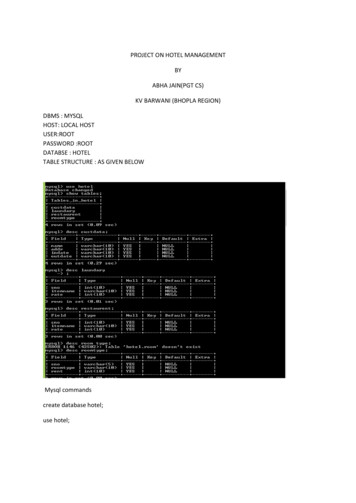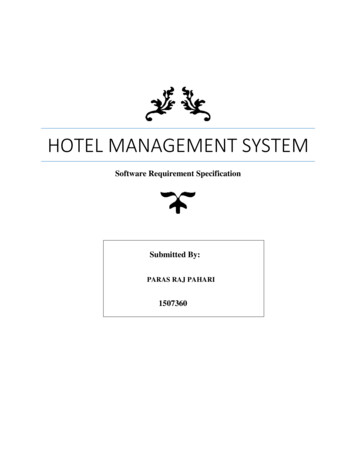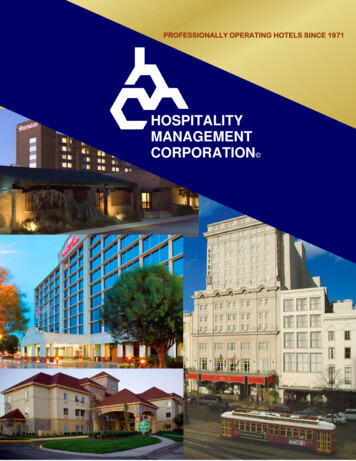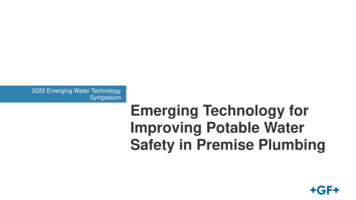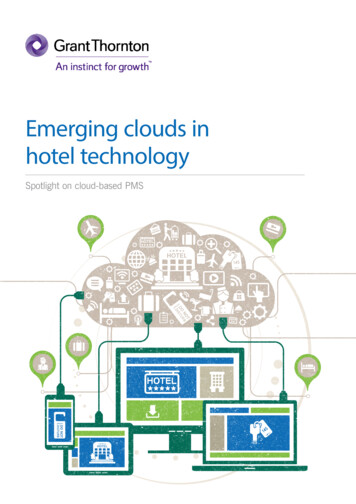
Transcription
Emerging clouds inhotel technologySpotlight on cloud-based PMS
The cloud-PMS opportunityCloud-based technology has seen rapid uptake in recentyears and Gartner predicts that in 2016 it will account forthe bulk of new IT spend. Appetite for cloud is growingand even the more conservative forecasts show strongglobal uptake over the next 2-3 years.The digital revolution has transformed the distribution and booking end of thehospitality industry with the inexorable rise of online travel agents and rapidevolution of consumer booking to online and mobile devices. Hotels themselveshave been slower to embrace new technology, preferring to stick to their tried andtrusted systems. But this is now changing.Hospitality is one industry which is at a tipping point interms of cloud adoption and in this paper we focus onone the most significant IT spend items for hotels – theproperty management system (PMS) – software whichenables the automation of all front desk activities and actsas the ‘back bone’ of the hotel.Signs now are that hotels are taking the plunge into cloudwith a new generation of cloud-based systems populatingand disrupting the hotel technology landscape. With a raft ofexciting new tech start ups helping to catalyse this transitionand the legacy hotel technology giants migrating theiroffering, cloud-based hotel technology is now moving fromearly adopter to mainstream status, representing an excitingopportunity for both hotels and investors alike. 3.8 billionspend on hotelsoftware in2015Positive underlying market drivers forcloud-based PMS Strong demand growth with hotel softwarespend forecast to grow at 7-8% over the nextthree years globally Continued professionalisation of hotels often driven bya younger generation of owners/managers together withnew build and consolidation activity are all driving newtechnology adoption Benefits of easier updates, more flexible remote accessand a simpler pricing model New generation of innovative technology playersemerging with mobile optimised solutions14% budgetspent on PMSPipeline of1.3 million hotelrooms in 2015187,000hotelsworldwide and17.5 millionroomslEmerging Clouds in Hotel Technology Spotlight on cloud-based PMS 1
Hotel technology spendProperty managementsoftware (PMS)With technology developments enabling improved customer experience andinteraction as well as revenue optimisation and cost savings, it is inevitable that hotels– both large and small – are looking at how to make the most of new technologyAs hotel operations have become more complex, hotelsoftware has been designed for all areas of hotel operationsin order to automate operational processes and assist staff /management to gather business intelligence and analyse vitalinformation in real-time.Hotel technology spend The global hospitality IT market was estimated to be worth 29.7bn in 2015. Software accounts for 12% of hospitalityIT spend and is forecast to grow at 7% pa from 2015-18,outstripping other segments.The challenge for hoteliers is the ongoing investmentrequirements, given the short lifespan of technology, thefrequent need for upgrades and the continual evolution ofconsumer technology and guest expectations . In addition,hotels may not always derive value from technologyinvestments if these are done only to keep up withcompetition rather than to align to the hotel’s strategicdirection. For example, self-service technology which hasbeen a feature of other industries like banking for manyyears is only now making an entrance into the hotel industry.However, selecting a room and checking-in prior to arrivalor doing mobile check-in through a kiosk may not suit everyguest’s expectations of what constitutes personalised serviceexperience and therefore has to be offered as an optionrather than imposed as the norm.IT spending in the hospitality industry is relatively lowcompared with industries such as financial services andtelecoms. Nevertheless, the hospitality industry is increasinglymaking use of technology to drive operational efficiency andengage with customers (from booking process to check-outand engagement post-stay). A recent study showed that in2015 on average 4.9% of hotel revenue was allocated to the ITbudget (vs. 2.6% in 2014), with guest-facing mobile technologythe spending priority for hotels1. Advances in technology havealtered the relationship between hotels and guests: From the way guests research and book a stayconsumers increasingly prefer to book online and viamobile (as attested by a 2014 study which shows 57%of hotel bookings are made online and 65% of same-daybookings are made via a mobile device2). This meansintensified competition between OTAs and hotels tocapture surfing consumers3.03.23.53.84.1Technology spendTop tech priorities for hotelsin 20154432.631.530.629.728.627.527.1Global hospitality technology spendby segment ( bn3)To the increased technological needs and expectationsof guests which hotels aim to satisfy (as evident fromfree high-speed wireless internet access across the hotelareas, check-in kiosks and mobile keys).Data CentreDevices4.44.7 SoftwareTelecomServicesInternalServicesGuestroom Technology17%Networking Bandwidth/Connectivity15%14%PMS10%Payment Security9%Point of Sale SystemIT ServicesCustomer RelationshipManagement8%7%Revenue Management2012 2013 2014 2015 2016 2017 2018YRYRYRYRYRYRYRlWorkforce Management2 Emerging Clouds in Hotel Technology Spotlight on cloud-based PMS5%Customer-facingmobile solutionsPMS in hospitality technology3rd party bookingsOTAsDirect bookingGDSWebsiteMobileSocial mediaChannel managementAdvanced modulesCore PMS modulesEPOSRevenueoptimisationGuestmanagementCRM Rates Group Inquiry Inventory Profiling History ContactFrontdeskLeisure/events modulesHousekeeping/maintenance Reservation Check-in Check-out Night audit Billings Schedule Task assign Maid Mgmt Inventory Items mgmt MobileupdateRevenue/yield38%Preparing for changesin payment technologyBackofficeFood and beverage Ledger Bills Travel agentinvoicing AdvanceddepositConferencesSpaCentral reservationsOther(eg golf, casino, resort)Reporting and analytics29%Securing data22%Migrating to the cloud22%Developing adigital strategyHoteliers are prioritising technology investments thatcan provide consumer facing mobile solutions and cloudadaptability. Consequently, PMS cloud solutions that enablemobility - for both customers and hotel staff – are in demand.40%Adding bandwidthLeveraging mobilesolutions for employeefacing applicationsPMS represents the back-bone of hotel operations andinterfaces with a variety of other key systems from channelmanagement and bookings to hardware such as telephonyand key rooms. In the past, PMS was used to manageguest check-in and check-out and housekeeping services.However, now PMS covers the entire guest experience,including the booking process to capturing guest data forfuture interaction.Larger hotel groups with international operations may optfor an ERP solution, whereby a technology supplier offersa comprehensive end-to-end solution integrating frontdesk and back office functionality. Although the conceptof an ERP in the hospitality industry is still relatively new,it offers numerous advantages in terms of seamless use oftechnology, more automation, greater visibility into hoteloperations, optimised use of manpower, reduced revenueleakages and higher resultant profits.ERP applications interfacesHR and PayrollFinanceHardware interfacesWorkforce 0%Modules from PMS providerPotentially provided by PMS provider or a 3rd partyProvided by 3rd partyInterfaces typically developed by PMS providerlEmerging Clouds in Hotel Technology Spotlight on cloud-based PMS 3
PMS uptake in hotelsEvolution of PMS: fromon-premise to web-nativeThe market for PMS is well developed in the more mature countries of westernEurope and the US. We estimate that the current penetration across hotels is as highas 80-85% in the US and UK. Overall penetration is somewhat lower in the morefragmented hotel markets of Italy and Germany which have a high number of smallindependent hotels.The most prevalent systems in place in hotels across Europeand North America are the traditional on-premise PMS,which are accessed via a desktop, with data stored in alocally based server.The cycle for replacement with on-premise systems, whichstill account for the majority of installed PMS, is every c. 5-7years for the major hotel chains, but many independent hotelswill hang on to their systems for as long as 10-15 years. Key factors which will influence the uptake of PMS in ahotel include:The penetration of hotel management technology willcontinue to increase in the next 3-5 years driven by: Consolidation – consolidation of the hotel landscape isexpected to continue. This will drive PMS uptake, givenchange in ownership and the increased demands of amulti-site operation Online-booking – the surge in bookings through onlinetravel agents (OTAs) and the rise of the online bookingchannel has been a key driver of technology adoption.With 71% of consumers globally now preferring tobook online5, more hotels have been investing in channelmanagers (to optimise online booking efficiency throughOTA and other channels), booking engines (to receiveand manage bookings directly through hotel website) andcentral reservation systems (to consolidate and managereservations across a portfolio of properties). Each ofthese systems will feed into and integrate with the PMSwhich is at the heart of the hotel’s operations Hotel size – this the most significant determinant ofwhether hotel management software is used. Hotels withfewer than 20 rooms will be much less likely to have aPMS and may opt to manage their reservations manuallywith pen and paper or spreadsheets. By contrast,penetration will be close to 100% in the larger hotels( 100 rooms)Ownership – hotel chains are more likely to have a PMSinstalled across sites and franchise chains will also oftenstipulate use of PMS and have one or two preferredsuppliers for PMS systems. Independent hotels whichcan often be family run establishments are less likely tohave adopted this technologyStar rating and facilities – PMS penetration is higher inthe 3 star and above categories. The breadth of facilities(restaurant, spa, conference) which 4 and 5 star hotelsare more likely to have also increases their need formanagement software and the efficiency benefits whichtechnology can offerOccupancy – the occupancy rates of hotels will have animpact on whether a PMS is adopted – lower occupancyhotels ( 30%) and seasonal hotels, for example will beless likely to have invested the capital in PMSLocation – uptake of PMS varies by location and ishigher in metropolitan areas as these tend to have ahigher proportion of online bookings which correlatesdirectly to the efficiency saving PMS can bringEstimated PMS penetration# hotelsUK85%80%US75%France73%ItalySpainGermanyl4 Emerging Clouds in Hotel Technology Spotlight on cloud-based PMSOverview of different PMS modelsHQHQOn-premise The traditional solution for PMS,typically installed on hotel computerand accessed via desktop Application hosted and data stored ona server located on the hotel premise Software application designed forMicrosoft Windows operating system Capital investment in hardware(computers, terminals, servers.)and upfront license fee for software(perpetual license). Updates areusually paid for Usually acquired with a contract forservice and maintenancePMS ystems are evolving, however, and the past decade has seenthe rise of a new generation of PMS with the introductionof agile, cloud-based models which have disrupted theestablished landscape. The leading hospitality technologyproviders, Oracle Hospitality, Infor, Protel have themselvesbeen updating and redesigning their products to offerdynamic web-based delivery and cloud storage withsubscription based pricing models. Systems have typically beendeveloped over a long time and haverich functionalityHQHybrid cloud Legacy solutions which have beentransitioned from on-premise (havingbeen written for Windows OS eg inJava) and given web front-end foraccess via browser on computer,tablet and mobile Can be hosted locally or remotelyfrom PMS providers’ server at datacentre May still have certain elements ondesktop Subscription based pricing model,typically calculated as a fee per roomper month Initial set-up fee (with additionalcharge for interfaces & training)/migration fee from on-premise Quicker to develop than web-native asdo not need to rewrite all of the code Greater depth of functionality thanweb-native as has all the functionalityof the legacy systemWeb-native cloud Designed purely as a web-basedsolution – optimised for tablet andmobile use Accessed via internet browser Can either be hosted via –– Private cloud – PMS providers’servers at data centre– Public cloud (eg Microsoft Azure)– often referred to as “pure cloud”and has advantage of being moreagile and open to multi-tenancy Designed specifically as web softwareand so mobile functionality is higher,typically easier to use and faster tolaunch updates Subscription based pricing - per roomper month with an initial set-up fee.Updates typically included in package Easier to interface with other systems Recently developed and so solutionscan lack the richness of functionalityrequired by hotels with complexoperations Needs internet connection to operatelEmerging Clouds in Hotel Technology Spotlight on cloud-based PMS 5
Advantages of cloud fromhotelier perspectiveCurrent penetrationof cloudFrom a hotelier perspective, the cloud offers a more agile, flexible and costeffective solution for PMS. Its benefits vary in significance depending on the hotelcharacteristics: the simplicity, remote access and affordability are key advantagesfor the small hotelier, whereas the ease of multi-site management, rapidity ofdeployment and scalability are a major advantage for larger hotel chains.EuropeAsia PacificCloud penetration varies across Europe and the world,depending upon the relative rate of transition from theolder generation of hoteliers to the next generation, and theefficacy and coverage of internet infrastructure.The flourishing tourism industry with a younger hotelinfrastructure and high number of new hotel openingsin many of the Asia-Pacific countries such as Thailand,Malaysia and Indonesia make these markets fertile groundfor cloud-PMS adoption. Openness to technology is highand a younger generation of entrepreneurial hoteliers arereceptive to the benefits cloud brings. For many of theEuropean and US-based cloud PMS providers, Asianexpansion is a key short term priorityAdvantages of cloudRemote access and mobileoptimisation Web-based solutions enable hoteliers to keep on top of bookings and other elements of hotelmanagement any time, anywhere - a key advantage for independent hoteliers who need no longer betied to the front desk The optimisation for mobile access ensures ease of access via smartphone or tablet for hotel staff(waiting, housekeeping etc)Speed and fluidity ofupdates, integration andcommunication with thirdparty software Software updates can be rapidly deployed online and usually do not incur additional fees The communication with third party systems – OTA, GDS etc – is enhanced eg with room availabilityupdated in real-timeSimpler and less expensivepricing Total cost of ownership for cloud-based PMS is generally lower and the all-inclusive, subscription-basedper room fee appeals to hotels The switch from Capex to Opex for PMS is a major incentive for some hoteliersIntuitive, web-optimisedinterface Solutions which have been entirely created or redesigned for the web tend to have simpler, more intuitiveinterfaces making them easier to use The more complex on-premise systems can require weeks of training, whereas the newer cloud-basedsystems can be taught in a matter of days through in-person and/ or online training modulesEase of managingmulti-site operation The above-property, remote management enabled capabilities of cloud solutions facilitate control ofmultiple properties - enable visibility and management of individual properties from one device atany timeSpeed of deploymentand scalability Cloud solutions can be rapidly deployed and scaled-up at a much lower cost than traditional solutions– a key advantage for fast expanding hotel chains Public cloud solutions have added benefit of being geo-redundant“The real demand for cloud comes when youhave a concentration of hotels – or hotel ownerswhich have several hotels and want to be able tocontrol / access them all remotely”l6 Emerging Clouds in Hotel Technology Spotlight on cloud-based PMS“Typically other industries use cloud because itis easy to install and deploy, you get much morein terms of economies of scale. Therefore, theinfrastructure is bigger and powerful than youwould build in your own environment”Europe is characterised by a fragmented hotel landscapewith many small, independent hotels, and patchiness ofinternet infrastructure in more remote areas.The UK leads the way in cloud PMS adoption. The relativelyrobust internet infrastructure, openness to new technologyand presence of a strong domestic cloud PMS provider haveall contributed to this shiftSpain offers considerable potential for cloud players withsignificant recent improvement in internet infrastructureand openness to technology making web-based PMS ripefor adoption. Cloud-based solutions are also gaining tractionin France and Italy with strong uptake anticipated in thenear term.German hoteliers have been less receptive to PMS solutionsdespite having strong domestic cloud offerings andmigration is expected to be slower due to the fragmentationof the hotel landscape (a high number of very small hotels)and conservative nature of the hotelier base. Austria andSwitzerland have also been much slower to adopt.Cloud as a proportion of installed PMSsystems % he US plays host to a high number of pure-cloud players,many of which are targeted at the small hotel bracket andthese companies have been gathering impetus with their lowcost and ease of use a strong attraction. Uptake has beenslow amongst the hotel chains which dominate the hotellandscape and overall penetration has therefore been limited.There are signs that cloud adoption is now at a tipping point,however, and will accelerate over the next 2-3 years. Oncemore of the larger chains embrace the cloud, the balance willshift dramaticallylEmerging Clouds in Hotel Technology Spotlight on cloud-based PMS 7
Competitive landscapeSupplier overviewThe global PMS technology supplier market is very fragmented and with the adventof cloud many start ups have entered the market in recent years. In addition, GDS,channel managers and booking engines are entering the PMS market, making thelandscape even more crowded.Functionality Regional players such as Protel, Itesso, PAR SpringerMiller National “champions” such as Guestline (UK),Quatuhore/Vega and Medialog (France), GP Dati (Italy)and Tesipro (Spain) A long tail of niche players (mainly cloud start-ups)PMS suppliers usually market their solutions to both chainsand independent hotels with many players having developedExamples of GDS providers that have entered the marketinclude Amadeus (acquisition of Itesso in 2015) and Sabre(acquisition of SoftHotel in 2011). Their one-stop-shopoffering is most appropriate for large hotels and targeted atwinning chains.Channel managers and online booking engines areincreasingly acquiring or developing products with somelimited PMS functionality eg Little Hotelier by Siteminder,typically targeted at the less than 20 room market.Market positioning of key PMS playersIn houseOracleProtelItessoGlobal /international chainsInforGuestlineOther (mainlynational andlocal players)Accounting & financeProcurement HR &payrollERP modulesRevenue/ yieldmanagementCentral reservationPCRMPAdvanced PMSEPOSReporting/ analyticsLeisure/ eventsBack officeHousekeeping/maintenanceRevenue optimisationFront deskIn the battle to offer a complete platform which is fullycentred around the guest experience, global distributionsystem (GDS) players, channel managers and bookingengines have recently entered the PMS market, usuallythrough acquisition. Given their scale and distributionpower these new entrants can pose serious challenges totraditional PMS players at both ends of the spectrum.Online bookingFuture competitive landscapeCore PMSConferencesGlobal players such as Oracle Hospitality (Micros)and InforBookingFood & beverage CompanyChannel managementThe supplier landscape can be segmented into:Supplier hospitality product overviewWeb-nativeNumber of PMS suppliersspecific PMS solutions for large group vs small/limitedservice hotels. However, they tend to target and gain moretraction in some hotel segments rather than across the board.HybridThe global PMS industry is very fragmented. A PMSsupplier count on Capterra (a software comparison website)reveals 246 suppliers, of which 50% offer web-nativesolutions and an additional 14% offering both web-nativeand on-premise PMS.On-premiseTraditional PMS players and their target customersAll the major players have comparable functionalityin their PMS offering, with little to provide significantdifferentiation, aside from the intuitiveness of the userinterface, the ability to facilitate mobile/tablet usage by bothguests and staff, and the richness of connectivity with inhouse and third party systems.Longer term, most players believe PMS will be slowlycommoditised, given the limited differentiation in productfunctionality; as a result they are investing in developingmore comprehensive hotel management systems as well anon-going product enhancements.Large InternationalOracle HospitalityPInforPProtelPItessoPSabrePAR Springer-MillerPSmall InternationalLittle HotelierClock SoftwarePCMS HospitalityPCeniumPPPIDS NextAgilysysPPEviivoFranchisesHotelogixNational chains &independent hotelsof 50-100 roomsHetrasNorth AmericaSmall independenthotels (10-50rooms)MaestroPInnRoadMicro hotels( 10 rooms)Often done manuallySource: Grant Thornton interviewsInnSoftPNote: P Partners; A lot of PMS providers state that they have their own channel manager when they actually repackage a third party’s as their own. It is not always clear from the websites ifthis is the casel8 Emerging Clouds in Hotel Technology Spotlight on cloud-based PMSlEmerging Clouds in Hotel Technology Spotlight on cloud-based PMS 9
Supplier overviewKey Country ProfilesSupplier hospitality product overview continuedAccounting & financeProcurement HR &payrollERP modulesRevenue/ yieldmanagementCentral reservationCRMAdvanced PMSEPOSConferencesFood & beverageReporting/ analyticsLeisure/ eventsBack officeHousekeeping/maintenanceRevenue optimisationFront deskCore PMSOnline bookingChannel MSIAutoClerkPEzee TechnosysPSilverbyteBooking CenterGracesoftPUKGuestlineIHotelligencePAvon DataPHotel PerfectPPPPPWelcomeAnywhereAlacerPFranceQuatuhore / VEGAPPMedialogPPPPMisterbookingChloe PMSPGermanyGubseIbelsaPItalyPGestione AlbergoHQ SoftPPAlpha ServiceNote: P Partners; A lot of PMS providers state that they have their own channel manager when they actually repackage a third party’s as their own. It is not always clear from the websites ifthis is the casel10 Emerging Clouds in Hotel Technology Spotlight on cloud-based PMS
The British hotel marketThe French hotel marketHotel landscapeAdoption of cloud-based PMSHotel landscapeAdoption of cloud-based PMS Independent hotels make up 66% of all hotels Independents make up 77% of hotels New hotel openings*: 119 New hotel openings : 86 hotels with 15,281 rooms Average hotel size: 46 rooms Average hotel size: 36 rooms Average size of Independent hotel is 24 rooms, andaverage size of chain hotel is 89 rooms Average size of independent hotel is 25 rooms, andaverage size of chain hotel is 80 rooms Cloud adoption expected to grow in the next 5 yearswith increasing hoteliers’ awareness of its benefits– “There is higher uptake with smaller hotels thanlarger ones currently” (PMS Provider)Current PMS penetration Our primary research bottom-up assessment suggeststhat 3,905 hotels are using cloud PMS, which is 32% ofthe hotels marketThe current penetration of PMS is c. 90%– “We are seeing a major shift to those looking at cloudin the independent hotel sector – they think that if itworks for the big guys then it’s all right for them”(PMS Provider)– “Penetration of hotels with over 10 rooms must bewell into the 90’s as it is very difficult to managemultiple channels and inventories without a PMSsystem. Even people like Best Western and otherconsortiums now mandate that their hotels use aPMS system” (PMS Provider) Current penetration of PMS is c. 75%– Highest in the 100 rooms bracket, where it is closeto 100%– It is much lower in the 20 room bracket c. 50% Uptake of PMS is higher in urban areas and would behighest in the Ile de France (Paris) region 201 rooms3%101-200 rooms9%15%51-100 rooms19%26-50 rooms30%11-25 rooms24% 10 rooms*2017 forecastSource: Grant Thornton interviews, Lodging Econometrics, STRl12 Emerging Clouds in Hotel Technology Spotlight on cloud-based PMS Large international hotel chains and resorts targeted byOracle Hospitality, PAR Springer Miller and Itesso oruse in-house PMS system30-150 room hotels – generally independents andsmall chains - targeted by Infor, Sabre, Protel, Itesso,Hotelogix, Guestline and Opera Lite Local and region focused players also do well – Clock,Hotel Perfect in South West, and Ihotelligence in Ireland Small hotels ( 30 rooms) –targeted by new entrantsLittlehotelier, Eviivo, Avondata, Hetras and WelcomeAnywhereTotal hotels 18.3k100 roomsShift to cloud should accelerate in coming years – cloudPMS expected to account for 20-25% of PMS systems in3 years’ time.– “Out of the PMS players active in France there are15% pure web / cloud, probably 50% who do bothon-premise and cloud and then 35% who do just onpremise” (PMS Provider)Competitive environmentTotal hotels 13.1kHybrid cloud solutions have gained more traction thanpure cloud as hotels prefer back-up of server and thereare more hybrid versions available on the market– “Clients like to own their license. With the purecloud – it is all 100% rental essentially and youdon’t actually own anything. If you are talkingabout “pseudo Cloud” – such as VPN – where theclient owns license and has online safeguard, there isgoing to be exponential growth. In five years’ time,everyone will want to have a ‘pseudo cloud’ solution”(PMS Provider)– “There are 18,000 hotels in France and I would saythat for every 10 contacts that we approach, there willbe 2 or 3 who are not using any software”(PMS Provider)– “Sales in the UK currently - pure cloud 5% , hosted60-65%, on premise 35% – in three years decliningsales of windows based system – big spike in cloud /steep curve upwards” (PMS Provider)– However “More hotels are moving to cloud, buta lot have server based system which they will keepusing until it stops working” (PMS Provider)– “For the independent hotels, cloud penetration is notmore than 15%” (PMS Provider)Current PMS penetration The current penetration of cloud and cloud-hybrid PMSis estimated at c. 10-15%4%Competitive environment21-100 rooms55%11-20 rooms27%0-10 rooms14% Oracle, Protel and Itesso focus on larger hotels Along with Infor, French national players target the20-100 room hotels and have high awareness –Quatuhore (Vega), Sequisoft/Cegid, Medialog,Topsys and Fiducial Pure cloud players also targeting this segment –Misterbooking, Conservus, ThaisSoft The micro segment is targeted by more basic cloudofferings from players which include Eviivo andFamilyhotelSource: Grant Thornton Lodging Econometrics, STR, INSEE, PKF hotel consulting, Horwatch HTL, TophotelprojectslEmerging Clouds in Hotel Technology Spotlight on cloud-based PMS 13
The German hotel marketThe Italian hotel marketHotel landscapeAdoption of cloud-based PMSHotel landscapeAdoption of cloud-based PMS Independents make up 89% of hotels Independents make up 96% of hotels and 87% of rooms New hotel openings : 554 hotels with 77,142 rooms New hotel openings : 81 hotels with 10,301 rooms Average hotel size: 28 rooms Average hotel size: 33 rooms – “Perhaps up to 10% of hotels are currently usingcloud, but it could be slightly lower” (PMS Provider) Current PMS penetrationThe current penetration of PMS is c. 60-70%– Highest in the 100 rooms bracket, close to 100%– It is much lower in the 20 room bracket, with higheruptake in the medium sized hotelsThe current penetration of cloud (web native PMS) isestimated at less than 10% – “Penetration of PMS overall is lower in Germany 60-70%, there are still a lot of small/independenthotels using pen and paper”(PMS Provider)Hybrid cloud solutions have gained some traction asplayers targeting larger hotels - Oracle and Protel, havedeveloped a hosted solution and moving chain hotels to itCurrent PMS penetration The current penetration of PMS is c. 70-75%Shift to cloud is not expected to accelerate at the samerate as in other EU countries in the short to mediumterm, although some smaller players expect a shift in thenext replacement cycle PMS uptake is higher in urban areas, especially in majortourist destinations – Rome, Venice, Milan, and Florence– Highest in the 100 rooms bracket, close to 100%– Much lower in the 25 room bracket– “Expect Germany will switch to cloud slower than therest of Western Europe Hotel owners like their databeing on site” (PMS Provider)– “Around 5 years ago, only 50% of small and mediumhotels ( 70 rooms) used a PMS system, however, thisfigure is now around 70-75%” (PMS Provider)– “Germany is less advanced due to market structure(large share of 20 roo
Advanced deposit Front desk Reservation Check-in Check-out Night audit Billings Reporting and analytics ERP applications interfaces Hardware interfaces HR and Payroll Finance Workforce management Entertainment Utilities Infrastructure Modules from PMS provider Potentially provided by PMS provider or a 3rd party Provided by 3rd party Interfaces typically developed by PMS .
